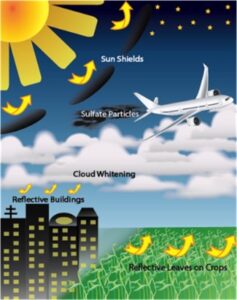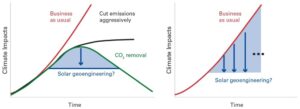Marcel Reichmuth
The process of man-made climate change can be summarised in four simplified steps. Firs there are our emissions that lead directly to the rise of the atmospheric concentration of greenhouse gases rises. An increased temperature is a consequence and the following impacts are the last step. Most approaches to prevent climate change approach at the first two steps, yet in this blog post I want to show the positive and negative aspects of solar radiation management as measure to prevent climate change.
When we talk about the climate crisis and policies to prevent it, we mostly just think about the mitigation of greenhouse gas outputs. Sometimes we even expand the idea to captioring the CO2 that already is in our atmosphere and storing it somewhere else. Those ideas have existed for many years now. At the UN conference on the human environment in 1972 principle Nr. 6, which says that “the discharge of toxic subtances and the release of heat, […], must be halted in order to ensure that serious or irreversible damage is not inflicted upon ecosystems” was defined and came up in other climate conferences ever since (Vasseur 1973). Yet as I see it many countries which are part of the Kyoto agreement still are not following their goal of emission reduction strong enough, to actually stay under a temperature rise of less than 2 degrees. It seems like our society and the decision-makers on our planet are not capable of cutting down our emissions from fossil fuels, which leads to needing another plan to prevent climate change. This is exactly where the idea of solar radiation management, which I think is not discussed enough, comes in.

Figure 56.1 – Illustration of Sample Solar Radiation Management Proposals (Erik Assadourian et al. 2013)
What is solar radiation management?
The idea of solar radiation management, also known as solar geoengineering, consists of creating reflective layers, which can be on different levels, to emit the suns short waved rays back to space. On the earth’s surface already having white panels on the ocean or painting roofs white is a way of altering the albedo effect. A comparable effect can be caused by spreading aerosols in the stratosphere. Giant sunshields in space are would also be a futuristic option with the same effect. Hereby the radiations would not even reach the earth and prevent it from heating. Although it seems like those ideas are not effective on a global scale, they could actually cut down the temperature quite efficiently. Let’s take the example of aerosols in the atmosphere. Sometimes when large volcanoes erupt, global cooling happens: sulfate aerosols get lifted up to the stratosphere and shape a reflective layer to solar radiations there. It has been observed after the Pinantubo eruption that the global temperature has dropped by 0.3°C for three years. So, if we manage to somehow cause a similar effect with the right measure this could help us to control the temperature at the surface (Gerlach 2022).
Another positive aspect of solar radiation management is, that it does not have a big influence on our standard of life. If we continue to try to reduce our greenhouse gas emissions, this almost certainly means that we will have to make major changes to our way of living, as many of our actions are linked to emissions. Typical examples there would be to renounce consuming livestock products or moving around with public transport instead of your own motorized vehicle. Whilst if reflectors would be set up somewhere or aerosols are spread this would not have a big impact on the private life of many persons. In this way changing our lifestyle to one with less emissions would no longer be so urgently necessary and there would be more time to invest in science and create sustainable alternatives for many of our products. The figure below symbolizes how this policy could bridge the time until technologies to effectively capture the carbon in our atmosphere and thereby lowering its concentration are found.

Figure 56.2 – (Left) A limited role for SRM (solar geoengineering) as part of a broad portfolio of climate change response options; (Right) An unrealistic scenario shows SRM used alone, without emissions abatement or removal of carbon from the atmosphere, leads to more and more SRM needed each year for an indefinite period of time. (D.McMartin and B.Kravitz 2019)
So why is solar radiation management not seen as equal alternative?
As we saw in the paragraphs above some of the methods of approach seem very unrealistic and in a scale way too big to realize them. Furthermore, if they get implemented, they have to be executed very carefully and in the right timescale. If the process was disrupted this would leaf to a very quick warming back to the normal level. So compared to other measures, like the mitigation of outputs, this one represents a very risky one. Moreover, it. is a method which could threaten the intergenerational justice by not giving the future generation the choice to abort the measure. So there again is the question how we should act, when we have to reduce one pillar of sustainability to increase another one (Saeed, Schleussner, and Hare 2018, Gardiner 2010).
A second negative point is, that by altering the reflected portion of incoming rays and lowering the temperature not every problem is solved. If it is misunderstood that thanks to solar radiation management nothing has to be changed in the lifestyle and fossil fuel emissions the atmospheric concentration of carbon and other greenhouse gases would still rise. The oceans acidification would just be one of the many still ongoing ecological consequences. Since the biggest part of carbon emissions is absorbed by the ocean, it is precisely the aquatic ecosystem that suffers the most. Following to that many important coral reefs and other aquatic species would be threatened. So yes, the global temperature could maybe be controlled but there are many other aspects of the climate which stay critical. (Saeed et al. 2018)
Is it possible just to apply some of the ideas without going all in?
In conclusion, the idea of solar radiation management is rightly a highly controversial issue. On one side it could be a legitimate alternative to simple carbon mitigation and captioning, but on the other side it is a quite risky idea to invest a lot of resources for such a delicate task. Some ideas of altering the albedo effect seem to have a very simple approach, like for example painting the roof white, and I still wonder, why they are not implemented more by the state. Yet when it comes to bigger scaled measures like sunshields, I absolutely understand the doubts. In addition to the already named negative points the coordination of such big projects and their financing represents a major hurdle for international politics. For me especially the aspect of intergenerational justice seems to be a very good justification to question such a project. It would be irresponsible if we started it without being a hundred percent sure it works and future generations suffered therefore.
References
Gerlach, Terrence M. 2022. “Volcanoes Can Affect Climate | U.S. Geological Survey.” Retrieved May 5, 2022 (https://www.usgs.gov/programs/VHP/volcanoes-can-affect-climate).
Saeed, Fahad, Carl-Friedrich Schleussner, and William Hare. 2018. Why Geoengineering Is Not a Solution to the Climate Problem.
Vasseur, Eric. 1973. “United Nations Conference on the Human Environment. Stockholm, 5-16 June 1972.” Water Research 7(8):1227–33. doi: 10.1016/0043-1354(73)90077-8.